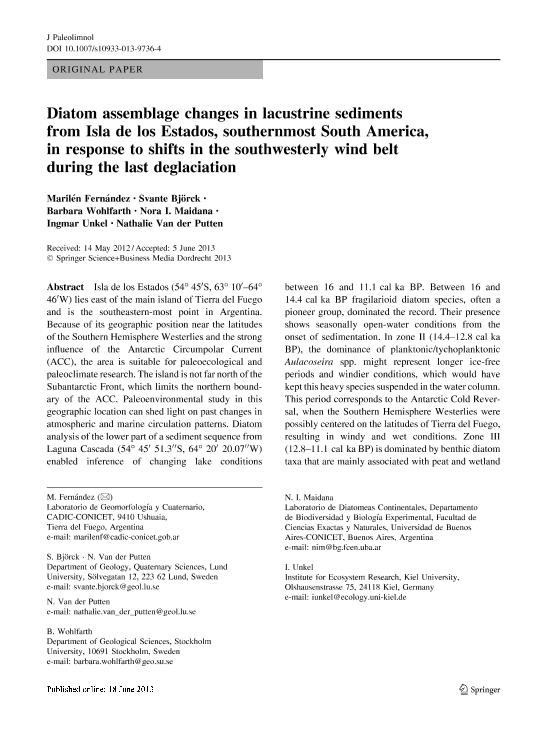Mostrar el registro sencillo del ítem
dc.contributor.author
Fernández, Marilén

dc.contributor.author
Björck, Svante
dc.contributor.author
Wohlfarth, Barbaria
dc.contributor.author
Maidana, Nora Irene

dc.contributor.author
Unkel, Ingmar
dc.contributor.author
Van der Putten, Nathalie
dc.date.available
2017-10-17T18:27:25Z
dc.date.issued
2013-06
dc.identifier.citation
Fernández, Marilén; Björck, Svante; Wohlfarth, Barbaria; Maidana, Nora Irene; Unkel, Ingmar; et al.; Diatom assemblage changes in lacustrine sediments from Isla de los Estados, southernmost South America, in response to shifts in the southwesterly wind belt; Springer; Journal Of Paleolimnology; 50; 4; 6-2013; 433-446
dc.identifier.issn
0921-2728
dc.identifier.uri
http://hdl.handle.net/11336/26739
dc.description.abstract
Isla de los Estados (54° 45′S, 63° 10′–64° 46′W) lies east of the main island of Tierra del Fuego and is the southeastern-most point in Argentina. Because of its geographic position near the latitudes of the Southern Hemisphere Westerlies and the strong influence of the Antarctic Circumpolar Current (ACC), the area is suitable for paleoecological and paleoclimate research. The island is not far north of the Subantarctic Front, which limits the northern boundary of the ACC. Paleoenvironmental study in this geographic location can shed light on past changes in atmospheric and marine circulation patterns. Diatom analysis of the lower part of a sediment sequence from Laguna Cascada (54° 45′ 51.3′′S, 64° 20′ 20.07′′W) enabled inference of changing lake conditions between 16 and 11.1 cal ka BP. Between 16 and 14.4 cal ka BP fragilarioid diatom species, often a pioneer group, dominated the record. Their presence shows seasonally open-water conditions from the onset of sedimentation. In zone II (14.4–12.8 cal ka BP), the dominance of planktonic/tychoplanktonic Aulacoseira spp. might represent longer ice-free periods and windier conditions, which would have kept this heavy species suspended in the water column. This period corresponds to the Antarctic Cold Reversal, when the Southern Hemisphere Westerlies were possibly centered on the latitudes of Tierra del Fuego, resulting in windy and wet conditions. Zone III (12.8–11.1 cal ka BP) is dominated by benthic diatom taxa that are mainly associated with peat and wetland vegetation. This suggests that climate conditions had become milder and less windy, favoring aquatic productivity and terrestrial vegetation development. This change in environmental conditions may have been a consequence of the southward movement of the Southern Hemisphere Westerlies at the start of the Antarctic Holocene thermal optimum.
dc.format
application/pdf
dc.language.iso
eng
dc.publisher
Springer

dc.rights
info:eu-repo/semantics/openAccess
dc.rights.uri
https://creativecommons.org/licenses/by-nc-nd/2.5/ar/
dc.subject
Diatoms
dc.subject
Biogenic Silica
dc.subject
Isla de Los Estados
dc.subject
Late Glacial-Early Holocene
dc.subject
Paleoenvironments
dc.subject.classification
Oceanografía, Hidrología, Recursos Hídricos

dc.subject.classification
Ciencias de la Tierra y relacionadas con el Medio Ambiente

dc.subject.classification
CIENCIAS NATURALES Y EXACTAS

dc.title
Diatom assemblage changes in lacustrine sediments from Isla de los Estados, southernmost South America, in response to shifts in the southwesterly wind belt
dc.type
info:eu-repo/semantics/article
dc.type
info:ar-repo/semantics/artículo
dc.type
info:eu-repo/semantics/publishedVersion
dc.date.updated
2015-06-11T18:20:54Z
dc.identifier.eissn
1573-0417
dc.journal.volume
50
dc.journal.number
4
dc.journal.pagination
433-446
dc.journal.pais
Países Bajos

dc.journal.ciudad
Dordrecht
dc.description.fil
Fil: Fernández, Marilén. Consejo Nacional de Investigaciones Científicas y Técnicas. Centro Austral de Investigaciones Científicas; Argentina
dc.description.fil
Fil: Björck, Svante. Lund University;
dc.description.fil
Fil: Wohlfarth, Barbaria. Stockholms Universitet;
dc.description.fil
Fil: Maidana, Nora Irene. Universidad de Buenos Aires. Facultad de Ciencias Exactas y Naturales. Departamento de Biodiversidad y Biología Experimental. Laboratorio de Diatomeas Continentales; Argentina. Consejo Nacional de Investigaciones Científicas y Técnicas; Argentina
dc.description.fil
Fil: Unkel, Ingmar. Kiel University. Institute for Ecosystem Research; Alemania
dc.description.fil
Fil: Van der Putten, Nathalie. Lund University;
dc.journal.title
Journal Of Paleolimnology

dc.relation.alternativeid
info:eu-repo/semantics/altIdentifier/url/https://link.springer.com/article/10.1007/s10933-013-9736-4
dc.relation.alternativeid
info:eu-repo/semantics/altIdentifier/doi/http://dx.doi.org/10.1007/s10933-013-9736-4
Archivos asociados
